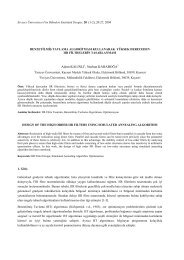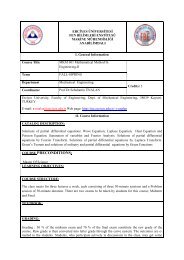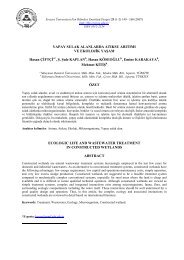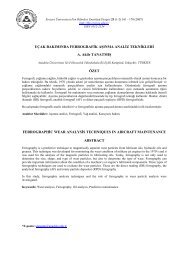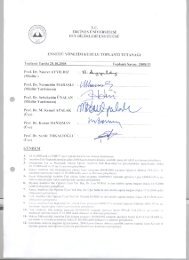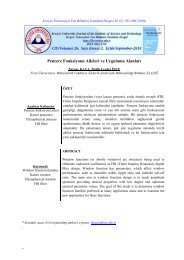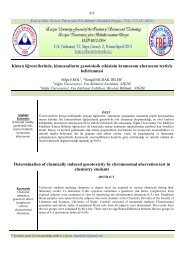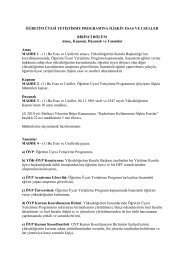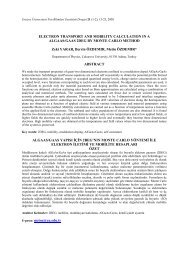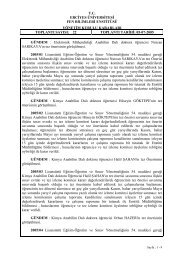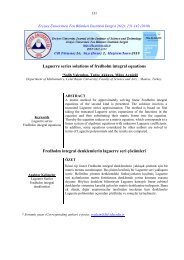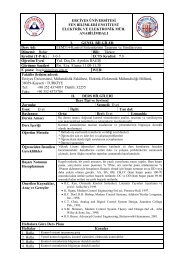MASK SELECTION FOR IMAGE PROCESSING Mehmet Sabih ...
MASK SELECTION FOR IMAGE PROCESSING Mehmet Sabih ...
MASK SELECTION FOR IMAGE PROCESSING Mehmet Sabih ...
You also want an ePaper? Increase the reach of your titles
YUMPU automatically turns print PDFs into web optimized ePapers that Google loves.
Erciyes Üniversitesi Fen Bilimleri Enstitüsü Dergisi 21 (1-2), 87-91, 2005<strong>MASK</strong> <strong>SELECTION</strong> <strong>FOR</strong> <strong>IMAGE</strong> <strong>PROCESSING</strong><strong>Mehmet</strong> <strong>Sabih</strong> AKSOYDepartment of Information SystemsCollege ofComputer and Information SciencesKing Saud University, Saudi ArabiaABSTRACTThere are many techniques for visual inspection. Four of them are (1) Image subtraction, (2) Dimensionalverification, (3) Syntactic approach and, (4) Feature Matching [1]. In Feature Matching or Template Matchingmethod, the image to be inspected is scanned and the required features are extracted. Then these features arecompared with those defined for the perfect pattern. This method greatly compresses the image data for storageand reduces the sensitivity of the input intensity data. A number of predefined binary templates can be used toextract the necessary features for images to be inspected. There are 28 different 3x3 templates which can be usedfor this purpose. For many applications some of this mask may be enough to use. The aim of this study is to helpto choose an adequate set of masks among the set of all possible 3x3 masks.Keywords: Industrial Visual Inspection, Template Matching, Image ProcessingE-mail: msaksoy@ccis.ksu.edu.sasabihaksoy@yahoo.com
Erciyes Üniversitesi Fen Bilimleri Enstitüsü Dergisi 21 (1-2), 87-91, 2005 91• Each image is represented by a set of mask’s frequencies. So the original images do not have to be stored inthe memory as an image. This saves memory space• The set of examples is proper for the use of an AI learning technique, for example Inductive Learning,Artificial Neural Networks etc.• It is easy and cheap to develop software and hardware for this technique since it is not complicated. .• The efficiency to correctly classify unseen examples was found to be 97% to 100% for many applicationsusing this technique.REFERENCES1. Roland, T.C. and Charles, A.H., “Automated visual inspection: A Survey”, IEEE Transac. On Pattern Analysisand Machine Intelligence, Vol. PAMI-4, No.6., 1982.2. Aksoy, M.S., G. Cagil., Turker. A., “Numberplate recognition using inductive learning”, Robotics andAutonomous Systems 870, 1-5, 2000.3. Ballard, D.H. and Brown, C.M. “Computer Vision”, Prentice-Hall, New Jersey, 1982.4. Sevkli, M., Turkyilmaz, A. and Aksoy, M.S. 2002 “Banknote recognition using inductive learning”, Int.Conf. On Fuzzy Syst. And Soft Computational Intelligence in Management and Industrial Eng.,FSSCIMIE’02, İstanbul Technical Univ., pp.122-128, Turkey, May 29-31, 2002.5. Turkyilmaz, Sevkli, M. and Aksoy, M.S., “Inspection of ceramic tiles using inductive learning”, 2nd Int.Conf. On Responsive Manufacturing ,ICRM-2002, Gaziantep Univ., pp.508-513, Turkey, June 26-28,2002.6. Aksoy, M.S., Torkul, O. and Cedimoglu, I.H., “An Industrial Visual Inspection System That UsesInductive Learning", Journal of Intelligent Manufacturing, 15, pp.569-574, 2004a.7. Aksoy, M.S. “Saudi Banknote Recognition Using Inductive Learning”, Accepted by Second InternationalIndustrial Engineering Conference, Riyadh, Saudi Arabia, December 19-21, 2004b.8. Aksoy, M.S. “Signature Recognition Using Inductive Learning”, Submitted to Journal of King Saud University,CCIS, Riyadh, Saudi Arabia, 2004c.



